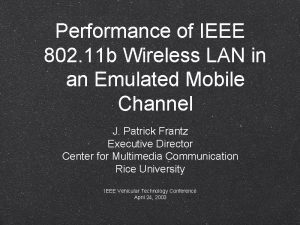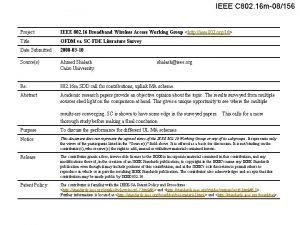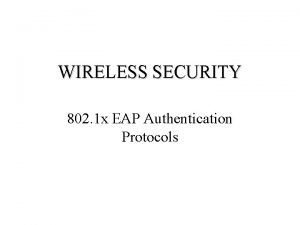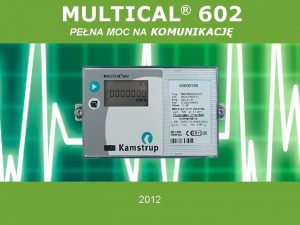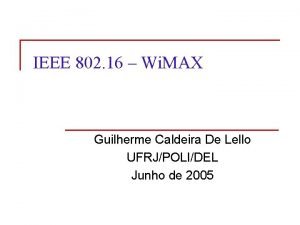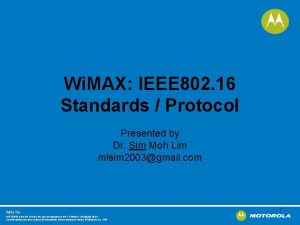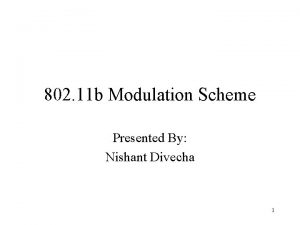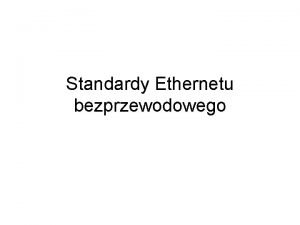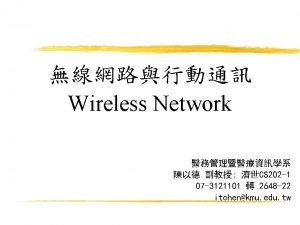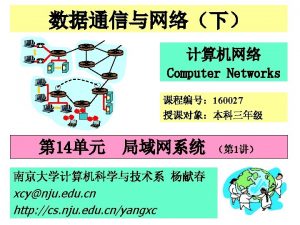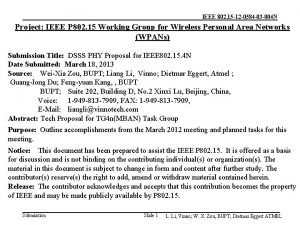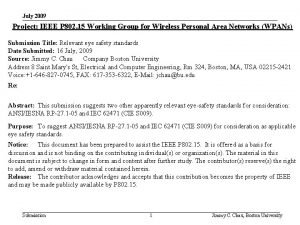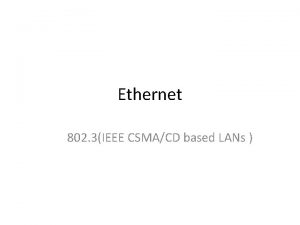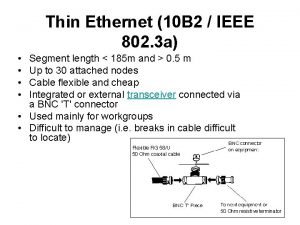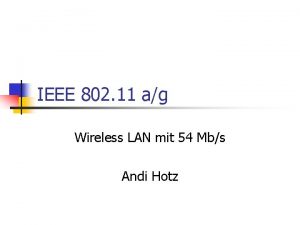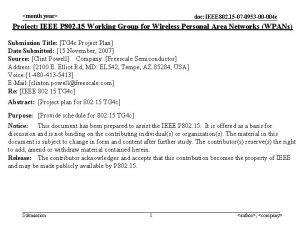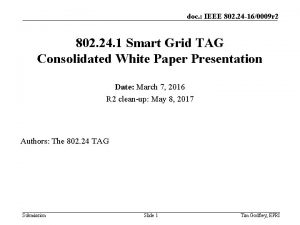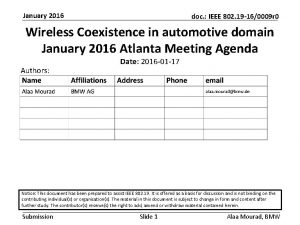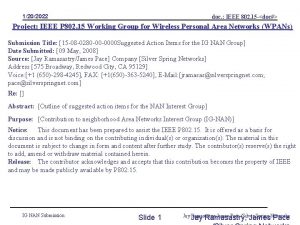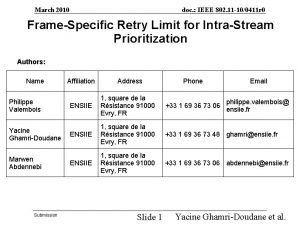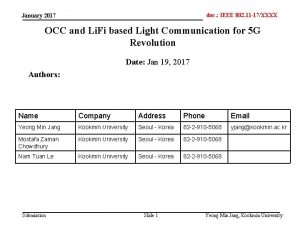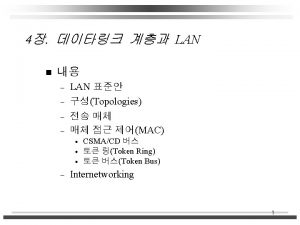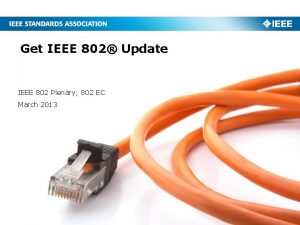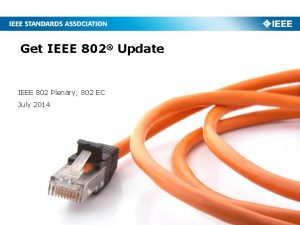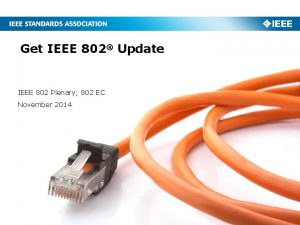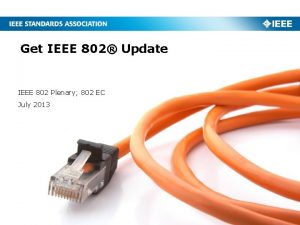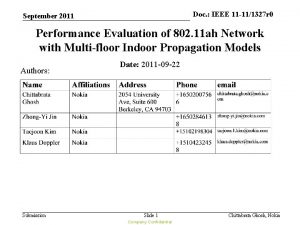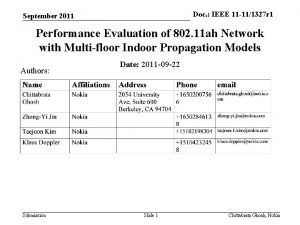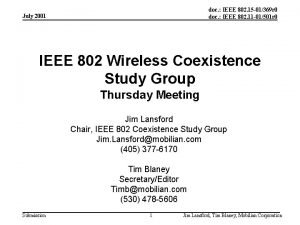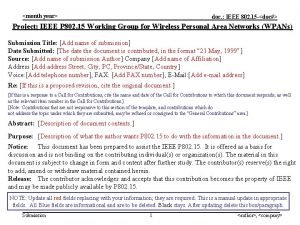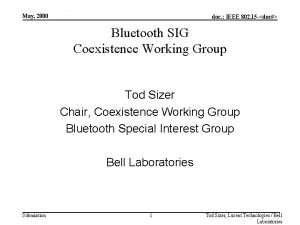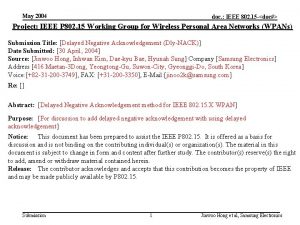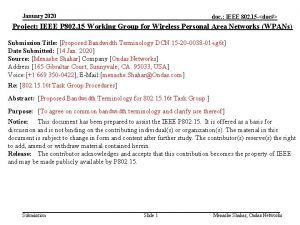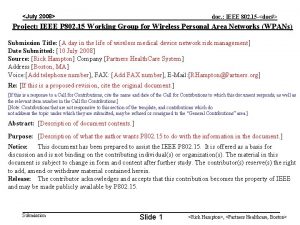doc IEEE 802 24 160009 r 0 802
































- Slides: 32

doc. : IEEE 802. 24 -16/0009 r 0 802. 24. 1 Smart Grid TAG Consolidated White Paper Presentation Date: March 7, 2016 Authors: Submission Slide 1 Tim Godfrey, EPRI

IEEE-SA Smart Grid

Smart Grid is defined as: Providing bidirectional communication of power quality, supply, and demand across the power grid to utilize electricity more dynamically resulting in increased energy efficiency and power grid reliability. This change is necessary to manage the increased variability caused by renewable resources, the increased peak demand created by energy intensive consumers such as electric vehicles, and to minimize the environmental impact of ever increasing aggregate demand for electrical power. 3

IEEE 802 and Smart Grid IEEE 802 networking technologies bring the following advantages to Smart Grid communications: • Enterprise grade security compatibility • Huge ecosystem (billions of products, hundreds of manufacturers) • Long-term (20 year), battery-powered operation • Continued operation during line fault events when using wireless media • Wide choice of products across the spectrum of power versus performance • Ability to be implemented in resource-constrained devices • Ongoing development of standards to address changing environment and technology • Wireless standards that operate in a licensed and license-exempt spectrum • Offers a rich set of data rate/range/latency tradeoffs • Common upper layer interface to seamlessly integrate into existing IT systems 4

IEEE 802 Standards Applicable to Grid Communications • IEEE Std 802. 1™ for bridging, time-sensitive networks, and link security • IEEE Std 802. 3™ (Ethernet) for wired LANs • IEEE Std 802. 11™ (Wi-Fi) for wireless LAN and HAN • IEEE Std 802. 15™ (Zig. Bee and Wi-SUN) for HAN and AMI networks (NAN) • IEEE Std 802. 16™ (Wi. MAX) for FAN and MAN • IEEE Std 802. 21™ for media independent handover and multicast group management • IEEE Std 802. 22™ for wireless regional area networks (WRAN) in TV white space (TVWS) bands 5

The Integrated Grid Graphic Courtesy of EPRI 6

Summary of utility communications protocols Application Layer Metering IEC 61968 CIM, ANSI C 12. 22, DLMS/COSEM, … Web Services, EXI, SOAP, Rest. Ful, HTTPS/Co. AP Other Applications Session Layer SCADA IEC 61850, 60870 DNP 3/IP, Modbus/TCP, … DNS, NTP, IPfix/Netflow, SSH RADIUS, AAA, LDAP, SNMP, … (RFC 6272 IP in Smart Grid) DTLS/TLS Transport Layer UDP/TCP Network Layer IPv 6/IPv 4 IPv 6 RPL Addressing, Routing, Multicast, Qo. S, Security 802. 1 X / EAP-TLS & IEEE 802. 11 i based Access Control LLC` Data Link Layer 6 Lo. WPAN (RFC 6282) IPv 6 over Ethernet (RFC 2464) 802. 15. 9 KMP M A C Physical Layer IP or Ethernet Convergence Sub. L. IPv 6 over PPP (RFC 5072) IEEE 802. 15. 4 e MAC enhancements IEEE 802. 15. 4 including FHSS IEEE 1901. 2 802. 15. 4 frame format IEEE 802. 15. 4 g 2. 4 GHz, 915, 868 MHz DSSS, FSK, OFDM IEEE 1901. 2 NB-PLC OFDM IEEE 802. 11 Wi-Fi IEEE 802. 3 Ethernet IEEE 802. 16 Wi. MAX IEEE 802. 22 WRAN 2 G, 3 G, LTE Cellular IEEE 802. 11 Wi-Fi 2. 4, 5 GHz, Sub-GHz IEEE 802. 3 Ethernet UTP, FO IEEE 802. 16 Wi. MAX 1. x - 3. x GHz IEEE 802. 22 TV White Space 2 G, 3 G, LTE Cellular

Overview of AMI Applications Meter Reading Theft Detection Prepay Metering Integration of Renewables Electric Demand Response Time Of Use – Service Disconnect/Reconnect – Outage and Restoration Management – Voltage and VAr Optimization (power factor monitoring) Gas / Water – Leak Detection – Seismic Event – Cathodic Protection 8

SG Network Architecture High level example of an Advanced Metering Infrastructure system Internet Data Aggreg ation Point May be called FAN or NAN Optional – within customer premises 9

Overview of DA Applications Distribution Automation (DA) involves monitoring and control of devices on the medium voltage (2 k. V to 35 k. V) grid, which provides the connection between a substation and customer transformer DA Applications include: – Voltage VAr (Capacitor Bank Control) • Compensating for reactive power losses due to inductive load by switching in capacitor banks on the distribution circuit – Voltage regulation • Compensating for voltage loss and varying voltage due to load by changing taps on a specialized autotransformer – Switching / Sectionalizers • Remotely switching the connectivity of the distribution grid to balance load or route power around damaged areas. 10

Security Overview Something on cyber security and IEEE 802 Scope limited to link-layer Support higher layer security protocols (required in most cases) Evolution to AES 256 – future List in SP 800 -57 References to FIPS, 2006 version, and later versions. We would like to show IEEE 802 fits into a comprehensive security architecture. Generally 802 provides layer 2 authentication and encryption. Show key management interfaces and mechanisms. Cypher suites NISTIR (Phil Beecher to provide this. Describe PKI, EAPOL, KMP, ) X – Y chart showing NISTIR requirements in rows, and 802 protocols in columns

802. 1 X Security 802. 1 X is the industry standard for port-based authentication on “Ethernet like” networks, and 802. 15. 4 networks with 802. 15. 9 KMP Supplicant can communicate only with Authentication server until authenticated. Various types of Extensible Authentication Protocol (EAP) are supported Once link security is established, Controlled Port is activated, granting full access. 12

802. 1 X Authentication • EAP enables master keys to be provided by Authentication server in secure location. • Master keys are not available at the edge

802. 11 Security 802. 11 originally offered Wired Equivalent Privacy (WEP) – Significant vulnerabilities were discovered (1) – now deprecated The 802. 11 i amendment updated the security architecture. The Wi-Fi Alliance developed two phases of Wi-Fi Protected Access (WPA) based on 802. 11 i – WPA was backward compatible to legacy 802. 11 b chipsets, using TKIP encryption. It has been deprecated. – WPA 2 has mandatory support for AES-CCMP encryption. WPA and WPA 2 can use different authentication methods: – WPA-PSK Pre-shared key entered by the user – WPA-Enterprise Uses 802. 1 X authentication in conjunction with a RADIUS server. Various forms of EAP are supported – WPS Wi-Fi Protected Setup – uses a PIN to simplify PSK setup, but introduces vulnerabilities in some implementations (1) https: //en. wikipedia. org/wiki/Wired_Equivalent_Privacy 14

802. 15 Security 802. 15. 4 security – AES-CCM-128 provides confidentiality and message authentication on the link layer. Supports both per peer keys and group keys. – How keys are used and created is left for the upper layers 802. 15. 9 KMP – Provides support for running existing KMPs over the 802. 15. 4 frames. – KMP frame fragmentation & multiplexing. – Supports creating and deleting both per peer keys and group keys. – Uses existing KMPs: IKEv 2, HIP, 802. 1 X, PANA, Dragonfly, 802. 11/4 WH, 802. 11/GKH, ETSI TS 102 887 -2. – Different KMPs have different authentication features: pre shared keys, raw public keys, certificates, EAP etc. 15

802. 16 Security 802. 16 has been deployed based on two standards with different security implementations. A few smart grid deployments were based on IEEE 802. 16 -2004, but most are using 802. 16 -2009. Standard Identity Authentication Mutual Authentication Replay Protection Cryptographic algorithms IEEE 802. 162004 X. 509 digital certificates PKMv 1 No Yes – packet numbering DES in cipher block chaining (CBC) mode (DES-CBC). 802. 16 -2009 802. 16 -2012 X. 509 digital certificates that include MAC address PKMv 2: RSA and EAP based authentication Yes – packet numbering DES-CBC and AES (with CBC, CTR, and CCM) 16

Security for 802. 21 d Multicast Group Management IEEE 802. 21 d standardizes a mechanism for distributing a symmetric key to group members, securely and efficiently. Group Ciphersuites: AES CCM-128 Encryption and message authentication ECDSA-256 Digital Signature Algorithm Group key distribution Ciphersuites Wrapping: AES_Key. Wrapping-128, AES_ECB-128 Message Authentication: AES-CMAC-128 Tim Godfrey, EPRI Slide 17

802. 22 Security Apurva: 802. 22 – GCM AES ECC 18

Non Mains and Low Power Applications Example applications that take advantage of low power operation, (water, oil/gas, line sensors) Example of “constrained” types of devices

IEEE 802 Standards for Grid Communications Networks IEEE 802. 3 IEEE 802. 11 IEEE 802. 3 1000 BASE-X IEEE 802. 22 IEEE 802. 16 IEEE 802. 11 (Mesh Topology) IEEE 802. 15. 4: (SUN, LECIM, TVWS) IEEE 802. 11 ah, 802. 11 af IEEE 802. 11 IEEE 802. 15. 4

Complementary Communications Technologies • Narrowband Power Line Communications (PLC) is used in some geographic areas for metering and other purposes. • Operation below 500 KHz • PLC technologies are difficult to scale into applications that do not have a connection to the electric grid (water, gas, etc) • IEEE P 1901. 2 • Commercial wireless network operators are often employed, both for backhaul and direct connection to grid devices and meters. Tim Godfrey, EPRI November 2014 Slide 21

Why is mesh networking used The advantages of mesh networks are: Extending connectivity to nodes that would otherwise be out of range To increase reliability if a node fails or is unable to communicate due to interference To provide redundant paths to backhaul networks To reduce power consumption due to shorter transmission distance 22

Example of Mesh Network http: //upload. wikimedia. org/wikipedia/commons/c/c 5/17_node_mesh_network. png Tim Godfrey, EPRI November 2014 Slide 23

Lifecycle Considerations • Many utility field networks and devices are expected to have a lifetime of 15 or more years. • IEEE 802 standards continue to evolve, but typically provide a backward compatibility path to older versions, enabling extended life cycles. Tim Godfrey, EPRI Slide 24

BACKUP SECTION Tim Godfrey, EPRI Slide 25

IEEE 802. 11 standards hierarchy IEEE 802. 3 802. 11 802. 15 802. 16 802. 21 802. 22 802. 11 a through 802. 11 z: Completed Active: More Grid relevant Active: Less Grid relevant 11 ac 11 ad 11 ae 11 af 11 ah 11 ai 11 aj 11 ak 11 aq 11 ax Higher rate in 5 GHz band Higher rate in 60 GHz band Prioritization of management frames TV White Space 915 MHz Band operation (sub 1 GHz) Fast Initial Association China Millimeter Wave Task Group General Link (full bridging over WLAN) joint with 802. 1 Pre-Association Discovery Task Group High Efficiency WLAN (HEW)

802. 11 – Spectrum / Rate view 500 MHz 1 GHz 2 GHz 5 GHz 10 GHz 60 GHz 802. 11 ac. 11 ad 500 Mbps 100 Mbps 802. 11 n 10 Mbps 802. 11 b 1 Mbps 802. 11 a . 11 p . 11 ah . 11 j . 11 af . 11 y 802. 11 g

IEEE 802. 15 standards hierarchy IEEE 802. 3 802. 11 802. 15 802. 16 4 e 4 g Active – More Grid relevant 4 k 4 m 4 n 4 q 4 r Active – Less Grid relevant Key Management Protocol Task Group 802. 22 Zig. Bee 802. 15. 4 Completed 802. 21 Smart Utility Networks (Wi. SUN) AMI LECIM Wi. SUN (AMI) for TV White Space Layer 2 Routing Task Group 802. 15. 9 802. 15. 10

802. 15. 4 PHY Overview (data rate vs frequency) 10 Kbps 5 GHz 100 Kbps 4 g 2 FSK 4 g O-QPSK 4 g ODFM 2 GHz 4 g 2 FSK 1 GHz 4 g 2 FSK O-QPSK 4 g 4 FSK CSS 4 g 4 FSK BPSK DSSS 4 g ODFM GFSK O-QPSK, ASK BPSK DSSS 4 g ODFM O-QPSK 4 g O-QPSK BPSK DSSS O-QPSK, ASK 4 g 2 FSK 4 g 4 FSK 4 g ODFM O-QPSK, ASK MPSK 920 915 868 863 780 500 MHz 4 g O-QPSK 4 g 2 FSK 4 g ODFM 4 g 4 FSK 1 Mbps CSS

IEEE 802. 16 standards hierarchy IEEE 802. 3 802. 11 802. 15 802. 16 802. 21 802. 22 802. 16 -2012 Completed – Grid Relevant 16 n 16 p 16 r Wi. MAX Completed – Less Relevant Active – Limited grid relevance Multi-Tier Networks 16 q Wi. MAX 2 High Reliability Machine to Machine 802. 16. 1 1 a 1 b Performance Metrics Small Cell Backhaul 802. 16. 3

802. 22 and other TV White Space standards

SG Network Architecture 32
 Bridges from 802.x to 802.y
Bridges from 802.x to 802.y Bridges from 802.x to 802.y
Bridges from 802.x to 802.y Ieee 802 family
Ieee 802 family Ieee 802 3 compliance
Ieee 802 3 compliance Wlan standards
Wlan standards Arquitetura ieee 802
Arquitetura ieee 802 Ieee 802 que es
Ieee 802 que es Ieee 802 standard
Ieee 802 standard Bluetooth ieee 802
Bluetooth ieee 802 802 ieee
802 ieee Ieee 802
Ieee 802 802 11 b
802 11 b Mac address
Mac address 802 16
802 16 802 eap
802 eap Kamstrup multical 802
Kamstrup multical 802 802 16
802 16 Geo 802
Geo 802 802 16
802 16 802 11
802 11 Standardy 802
Standardy 802 802 5
802 5 802 family
802 family 802 protocols
802 protocols 802 15
802 15 Ccna 640-802
Ccna 640-802 09 802 0561
09 802 0561 Ethernet 802
Ethernet 802 802-3-ethernet
802-3-ethernet Ssin-802
Ssin-802 Lan 701
Lan 701 Wireless lan 802
Wireless lan 802 802 15
802 15











